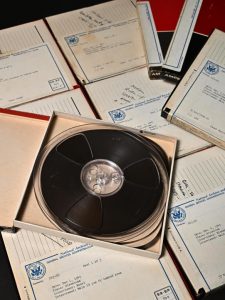Documenting Hiroshima of 1945: In December, United States conducts interviews with A-bomb survivors
Dec. 16, 2024
by Minami Yamashita, Staff Writer
In December 1945, the U.S. Strategic Bombing Survey team was conducting interviews with survivors of the atomic bombing in Hiroshima. The main purpose of the interviews was to investigate the impact of air raids that had taken place during the war on the fighting spirit of the Japanese people. The work had been conducted throughout Japan starting in November of that year.
The interviews consisted of 41 questions involving living conditions, as well as perceptions of the atomic bombings and the policies of the occupation forces. It was agreed that “the interviews would never be revealed to the Japanese people,” with the sessions lasting around two hours per person. Audio tapes of recorded interviews that the Hiroshima City government obtained from the U.S. National Archives and Records Administration in 1974 included 13 male and female voices of A-bomb survivors aged between 16 and 59 years at the time of the interviews.
One of the 13 survivors was Zoroku Miyagawa, the principal of Hiroshima Municipal Girls’ High School (Municipal Girls’ School; present-day Funairi High School). Listening to the recording while alive, Mr. Miyagawa was able to confirm that it was his own voice. According to a Chugoku Shimbun newspaper article dated November 27, 1974, reporting on his interview, Mr. Miyagawa had suddenly been summoned for the interview and taken to an office of the occupation forces in the area of Ebisu-cho (in Hiroshima’s present-day Naka Ward). He recalled, “I wasn’t informed of the purpose of the interview, and the atmosphere was like that of an interrogation with me as the subject of some kind of punishment.”
The Municipal Girls’ School had lost all 541 of its first- and second-year students who had been mobilized to help with building-demolition work near the hypocenter. Mr. Miyagawa had experienced the atomic bombing near Hiroshima Station, but he survived. In his interview by the survey team, he said, “I sent many students to the building-demolition work, all of whom died. I didn’t have the courage to face their families and therefore thought I should quit my job at the school as soon as possible in order to take responsibility.” He added, “After the war, the government and military didn’t offer any condolence or assistance for the students,” revealing his dissatisfaction with them.
Other interviewees that have been identified include Tetsuo Hayashi, a physician in the Imperial Japanese Army Shipping Command, and Kaleria Drag, a White Russian. The survey team interviewed a total of 248 people in the cities of Hiroshima and Nagasaki and nearby areas affected by the atomic bombings, compiling a report in 1947.
(Originally published on December 16, 2024)
In December 1945, the U.S. Strategic Bombing Survey team was conducting interviews with survivors of the atomic bombing in Hiroshima. The main purpose of the interviews was to investigate the impact of air raids that had taken place during the war on the fighting spirit of the Japanese people. The work had been conducted throughout Japan starting in November of that year.
The interviews consisted of 41 questions involving living conditions, as well as perceptions of the atomic bombings and the policies of the occupation forces. It was agreed that “the interviews would never be revealed to the Japanese people,” with the sessions lasting around two hours per person. Audio tapes of recorded interviews that the Hiroshima City government obtained from the U.S. National Archives and Records Administration in 1974 included 13 male and female voices of A-bomb survivors aged between 16 and 59 years at the time of the interviews.
One of the 13 survivors was Zoroku Miyagawa, the principal of Hiroshima Municipal Girls’ High School (Municipal Girls’ School; present-day Funairi High School). Listening to the recording while alive, Mr. Miyagawa was able to confirm that it was his own voice. According to a Chugoku Shimbun newspaper article dated November 27, 1974, reporting on his interview, Mr. Miyagawa had suddenly been summoned for the interview and taken to an office of the occupation forces in the area of Ebisu-cho (in Hiroshima’s present-day Naka Ward). He recalled, “I wasn’t informed of the purpose of the interview, and the atmosphere was like that of an interrogation with me as the subject of some kind of punishment.”
The Municipal Girls’ School had lost all 541 of its first- and second-year students who had been mobilized to help with building-demolition work near the hypocenter. Mr. Miyagawa had experienced the atomic bombing near Hiroshima Station, but he survived. In his interview by the survey team, he said, “I sent many students to the building-demolition work, all of whom died. I didn’t have the courage to face their families and therefore thought I should quit my job at the school as soon as possible in order to take responsibility.” He added, “After the war, the government and military didn’t offer any condolence or assistance for the students,” revealing his dissatisfaction with them.
Other interviewees that have been identified include Tetsuo Hayashi, a physician in the Imperial Japanese Army Shipping Command, and Kaleria Drag, a White Russian. The survey team interviewed a total of 248 people in the cities of Hiroshima and Nagasaki and nearby areas affected by the atomic bombings, compiling a report in 1947.
(Originally published on December 16, 2024)








